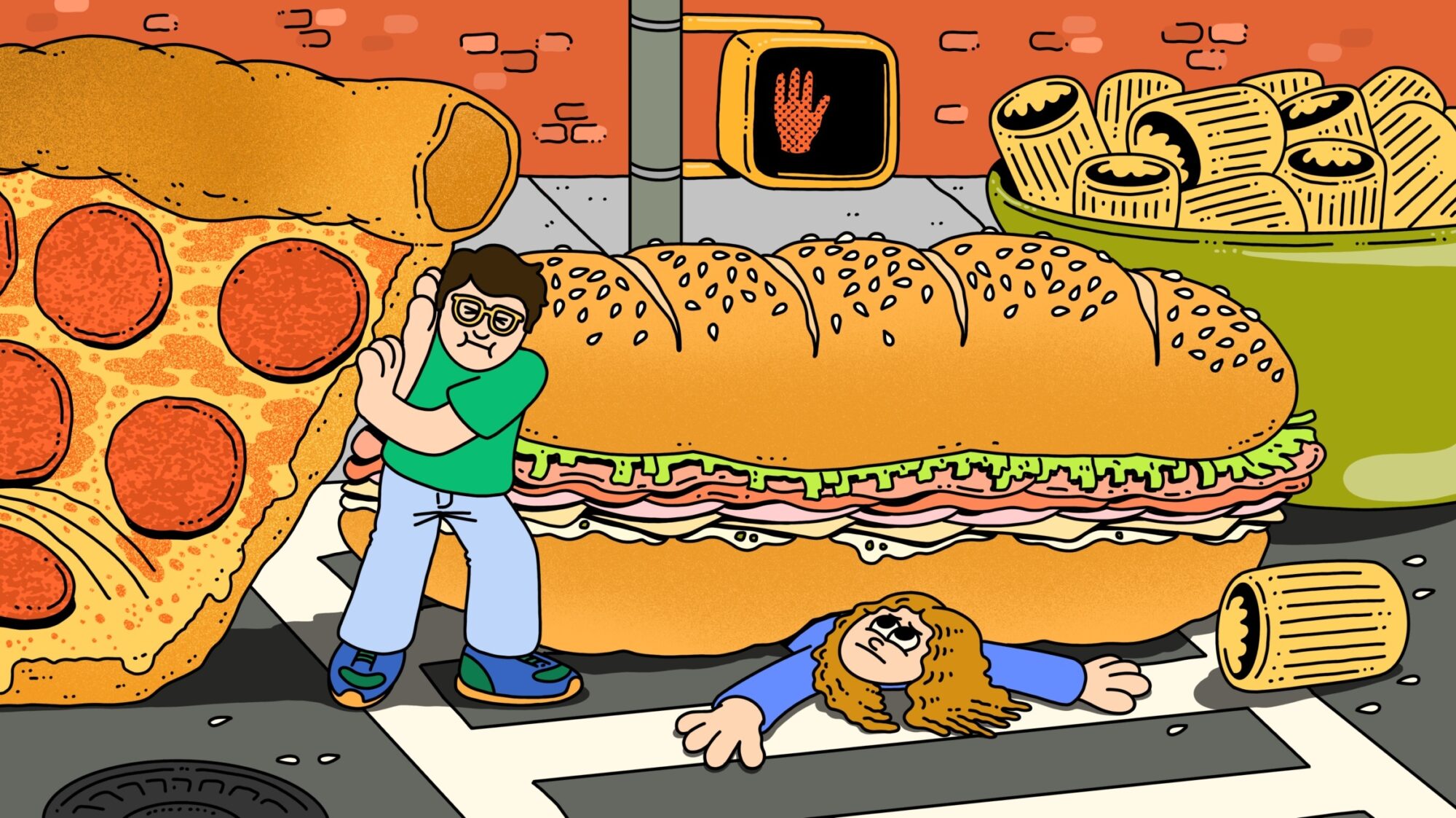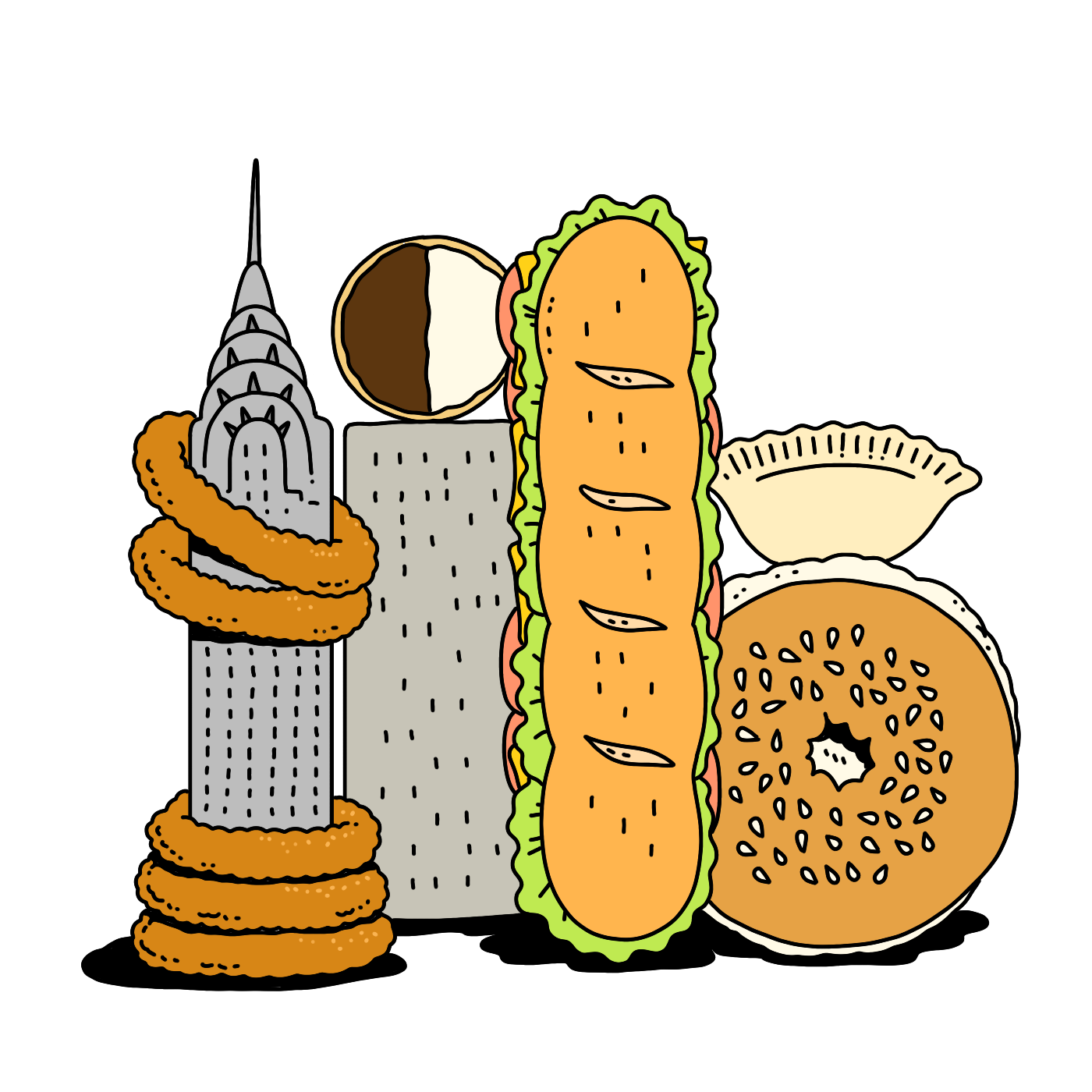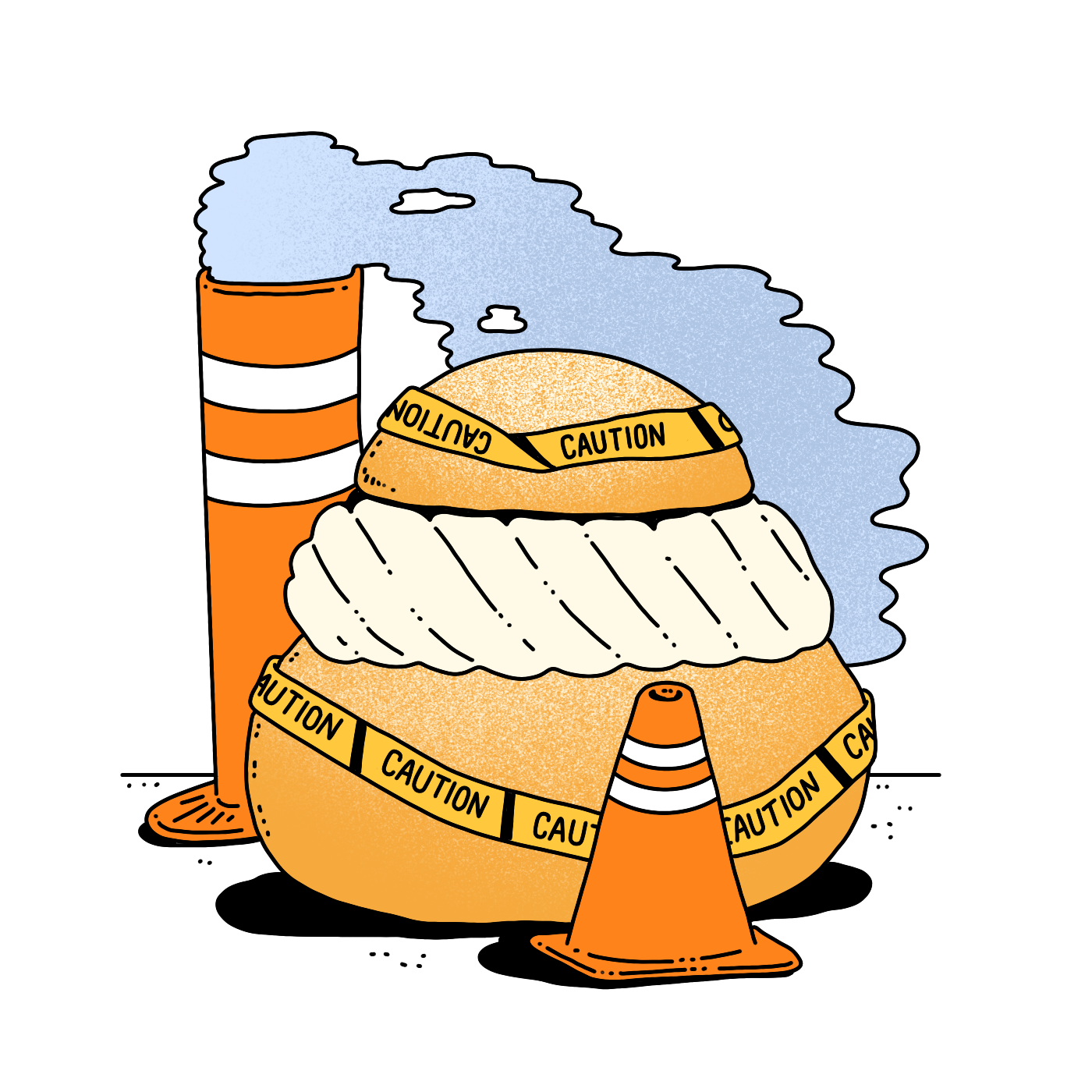
The delicious, depressing week between BC and AD—Before Celiac and After Diagnosis.
A friend recently quipped that if New York City had a terroir, it would be gluten. Did she mean that the bagels and bialys are legible in our famous tap water like sunshine and lava in an Etna bianco? I like that reading, but I think it’s more: if New York itself was a glass of wine, you couldn’t help but taste the pizza, babka, doubles, dumplings, and cheesecake humming underneath it all—the doughy, crispy, crumbly, stretchy, cakey foundation of the city itself.
So when my wife’s gastroenterologist prescribed a weeklong gluten binge a couple months ago, all of our city’s iconic foods—and our favorite places to eat them—were running through my mind. Doctor’s orders out of a dream, you would think, but in this case it was for a solemn, even paradoxical reason: to confirm suspected celiac disease.
Weeks of intense and concerning symptoms—abdominal pain, dizziness, brain fog, fatigue, insomnia, headache, loss of appetite—had culminated in this assignment, a surprising yet tantalizingly dainty resolution to what we feared was a medical mystery. Following a positive celiac panel Lauren had cut out gluten and finally seen some improvement. But the test results weren’t enough for a diagnosis; she’d have to get an endoscopy, and the doctor was clear: she needed to consume two units of gluten per day at minimum, or the results wouldn’t be accurate.
A serious autoimmune condition for which the only treatment is permanently following a strict gluten-free diet, celiac disease is not the same as a gluten sensitivity or allergy. Not every celiac has the same symptoms or severity, but the disease itself doesn’t exist on a spectrum—you either have it or you don’t.
If you do, it doesn’t just mean a life without couscous, spanakopita, or anything containing soy sauce at most restaurants, it also means staying vigilant about cross-contamination through sites like cutting boards and deep fryers. The amount of gluten necessary to spark an autoimmune reaction in somebody with celiac disease is minuscule, and even a tiny amount can cause damage to the small intestine and spur a host of potential complications: osteoporosis, cancer, and related autoimmune conditions like rheumatoid arthritis. In short, it sucks.

Well-meaning friends have noted (and I really don’t blame them) that there’s never been a better time to be gluten-free. But the best time for you or your partner to be diagnosed with celiac disease is never, especially if you care about food as much as Lauren and I do.
The two of us were at a tennis camp upstate when her first celiac screening came back positive. She didn’t know her GI had ordered the test, and the results arrived unexpectedly in an email from a lab, proffering enzyme values impossible for a layperson to interpret. Easier to parse was the clinical language at the top: “consistent with celiac disease but not confirmed.”
She wouldn’t see her doctor for another few days, but for a moment we thought that was it: her last piece of gluten would be a warm ciabatta roll taken distractedly from the salad bar at Total Tennis (which, for the record, has great food). Nonetheless, it felt like an unceremonious end to our shared gluten story.
The first time my parents met Lauren was at the Church of Sweden in Midtown Manhattan. It was just before Fat Tuesday, when the church sells its homemade semla, sweet cardamom rolls split in half, spread with almond paste, and filled with whipped cream. Lauren and I had recently joined the same band, and we slowly uncovered a freakish array of similarities, among them a shared fondness for (and awareness of) what Swedes eat before Lent. Neither of us has any Swedish heritage. My parents knew right away that things were serious.
As it turns out, the buns were just the beginning—our friendship blossomed into a relationship on tour. Some couples can map their early days with songs, but ours were soundtracked by our own band, the same set list every night for months. When we think back to that time, it’s the meals that stick out.
We slipped away from our bandmates for chocolate-pistachio escargots at Du Pain et des Idées in Paris, fish and chips by the pier in Brighton, and prune-filled buchty in Prague. We had planned a week in Rome and Puglia after the tour, and ate orecchiette on the streets of Bari, long before the local nonnas had their own Instagram accounts. Back in New York, the locations of seminal early date nights (Prune, Adelina’s), or even casual meals before or after band practice (Xi’an Famous Foods, The Islands), took on a special status for us.
Our love language was and is sharing meals—the vast majority of them containing gluten—and between tours we both pursued careers in or adjacent to food, I in food journalism and Lauren in illustration (with a focus on food). Our band toured full-time for almost five years, up until the pandemic, and we developed a shared rhythm that revolved around both cooking and seeking out memorable dining experiences around the world—fried calamari by the beach in Croatia, Liège waffles at gas stations in Belgium, late-night hotteok on the streets of South Korea. The first article we collaborated on was an illustrated guide to the snack foods of New Zealand, fastidiously researched between gigs.

These days, we both work from home and still eat together most of the time; at restaurants, like everyone, we share everything. As the reality of Lauren’s potential celiac diagnosis started to sink in, I realized soberly that I would become largely gluten-free by association. I thought of the chipper gluten-free lifestyle content creators that increasingly populated my discover page—their upbeat vibe didn’t resonate with me at all, yet soon my gut microbiome would be indistinguishable from theirs.
Until then, we had what Lauren and I started to call her “Gluten Rumspringa.” All things considered, the week until her endoscopy seemed like a generous amount of time to go around the city eating our favorite gluten-rich foods. But the stakes were different for Lauren as a born-and-bred New Yorker than they were for me, a transplant from Boston. The first stop called for comfort food, so I met her outside the doctor’s office, and we got started right away, heading to the nearby Old John’s Luncheonette to split a patty melt, a turkey club, chicken noodle soup, an order of onion rings, and an egg cream—a textbook NYC diner order made on autopilot.
It didn’t feel quite right, in part because this wasn’t one of “our places,” and it seemed like a weird time to try somewhere new. But celiacs must carefully vet most restaurants ahead of time, sometimes even calling ahead to confirm they can be accommodated. The meal at Old John’s, which ticked every box, represented a luxury we didn’t even realize we’d be losing: spontaneity.
The next day, we went to Agi’s Counter for New York’s best tuna melt on homemade potato pullman, plus a Caesar salad and a caraway-rye chocolate chip cookie to dunk into macchiatos, infusing its salty-sweet crumbs. On the way home, we stopped at Winner for a loaf of sesame sourdough and considered picking up some Pop’s beef or curry vegetable patties, but alarmingly—and uncharacteristically—Lauren didn’t want any. It soon became clear that two units of gluten per day, equivalent in our mind to two slices of bread, was a difficult minimum to maintain: Lauren’s abdominal pain never went away, and the neurological symptoms that had begun to dissipate started coming back.
The best time for you or your partner to be diagnosed with celiac disease is never, especially if you care about food as much as Lauren and I do.
We drove to Queens to meet a couple friends for lunch at the legendary Trinidadian spot Trinciti and split two bake and sharks, aloo pie, two doubles, kingfish curry, and buss up shut as smooth as satin sheets. Lauren gamely had half a bake and shark, but could only muster a few bites of the doubles and aloo pie. She tore tiny pieces of roti to scoop the channa and aloo. That night she fell asleep at 8:30 p.m., her fatigue worse than before. It was only Friday, and the endoscopy was scheduled for the following Wednesday.
Saturday lunch was at the newly opened Roscioli, where we’d eaten on our romantic first trip to Rome—this time an invitation came from Lauren’s brother, a food influencer who’d secured an elusive NYC reservation through some back channel. I watched as she struggled through a bowl of classic rigatoni alla carbonara and thought of the refrain we saw on positive Google reviews during our honeymoon, also in Rome, a couple years prior. The best pasta was always praised as “molto digeribile”—very digestible. Was it still?
Sunday brought a trip to Jersey City’s Bread & Salt, and by then the Rumspringa had taken on a decidedly downcast tone. We ordered finocchiona, gorgonzola, and fig jam on Rick Easton’s crisp, olive-oil-rich focaccia, plus a chocolate bun and a pasticciotto for later. This was unintentional, but we’d also first had pasticciotti on that same trip, in Puglia. I made turkey meatballs for dinner—nothing special, but they’d form the basis of Monday’s leftover meatball sandwiches with pesto, mozzarella, and 25-year-old balsamic brought out for the special occasion.
Tuesday’s main event could only be one thing. All week we’d been planning to go to L&B Spumoni Gardens for our favorite pizza, but time got away from us. We’d gone to the Upper West Side to spend a couple nights at Lauren’s parents’ place, and Mama’s Too was only a ten-minute walk away. Lauren got a square pepperoni slice with hot honey and a grandma slice, but brought the latter home to her dad. She just couldn’t eat any more.
The diagnosis came a couple weeks later, on the date we observe as our anniversary, eight years after that first tour. Lauren had already gone gluten-free after the endoscopy, but it took three weeks for her to finally start feeling better. As I write, it’s been more than a month, and she feels almost normal again. Since it isn’t medically necessary for me to avoid it, a dietician friend recommended that I continue to occasionally eat gluten, so I do, two or three times a week, but only things like a hot dog bun or an English muffin—sneaking off for a solo banh mi or a beef patty would feel adulterous, at least for now.
As we get used to our new lifestyle, it’s impossible not to think about all the things we didn’t get to share during that last week—tsukune at Sakagura, eun daegu jorim at Haenyeo, big tray chicken at Spicy Village. It’s a long, sad list full of delicious things. Even the cheesecake at Agi’s Counter, and we went there!
What we’re still mourning after the Rumspringa are not just food items but specific foods at specific places that nurtured our relationship and contoured our lives. There are gluten-free bagels, but not gluten-free Absolute bagels. There’s gluten-free pizza, but not gluten-free L&B pizza. There are gluten-free black-and-white cookies, but not the miniature ones from Barney Greengrass. To a potentially melodramatic degree, and at the risk of sounding greedy, these differentiations matter to us!
Our experience of some places won’t change, but our experience of others really will. Lauren can get sausage, peppers, and onions and a heaping plate of broccoli rabe at L&B while I eat pizza—that’s not so bad; we can still savor the atmosphere together even if we’re eating different things. Conversely, at most Chinese restaurants, her options are essentially limited to rice and NYC tap, which, terroir notwithstanding, isn’t a satisfying stand-in for mapo tofu or dan dan noodles.
But I keep thinking back to our first date, at the bygone lunch counter on the second floor of Kalustyan’s. We ate stewed eggplant with chickpeas, gigante beans floating in spiced tomato sauce, and heaps of fragrant mujaddara, studded with crispy onions gone soft among the lentils. I can still taste it. And actually, everything was gluten-free.